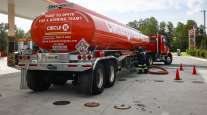Fleets Deploy Fuel-Saving Technologies Designed to Curb Wasted Miles, Time
This story appears in the Dec. 1 print edition of Transport Topics.
Maximizing fuel economy requires a lot more than a light touch on the accelerator pedal; it demands scrutiny of every mile and every moment that a truck is on the road. And factory-installed technologies and those installed on trucks from the aftermarket can help fleets do just that, executives and managers said.
“The most fundamental thing we focus on is not driving an unnecessary mile in the first place,” said Kelly Frey, vice president of product marketing for Aliso Viejo, California-based Telogis, a provider of routing software. “If we don’t drive that mile, we don’t incur any cost, liability risk, labor — nothing. When I bring this up, you get this quizzical look on people’s faces, like, ‘Isn’t that obvious?’ But 3% to 10% of all miles driven by commercial vehicles are unnecessary miles.”
For some fleets, cutting down on highway miles is a priority. For others, it could be reducing downtime at a destination. And beyond miles, some may seek ways to refine how loads are calculated to reduce miles traveled, even if it’s only a few miles per trip.
Frey said his company’s Telogis Route uses a variety of filters to look ahead at each trip. He speculated that if just one eliminated mile saved a fleet $1.50 in fuel and other costs, the benefit over the course of a year would be enormous. It is one of numerous technologies designed to help fleets plan ahead and avoid fuel-wasting activities — before a trip begins, while it’s in progress and when the driver arrives at a destination.
“Being able to identify those out-of-route miles in the most expedient way possible allows you to make corrections . . . while layering in the ability to work in [stops] like the cheapest fuel providers and preferred fuel networks,” said Jim Sassen, senior manager of product marketing for Dallas-based Omnitracs. He added that the company’s software is designed to help drivers decide when and where to make those stops.
“Being able to get that [information] to drivers is an important way to reduce fuel consumption and optimize fuel purchases,” he said.
Along with making smart decisions about where to stop is making good decisions about where to go, said Frey, noting that effective route planning includes consideration of when and why drivers make choices.
“We can find preferred fueling locations, parking locations for overnight, and we can include hours-of-service constraints in our route optimization,” he said.
“The first and last mile is where the driver has a chance to get lost, so applying route-optimization technology and advanced scripted planning offers a lot of opportunity to reduce miles.”
For example, at large delivery sites, drivers can burn up fuel just navigating the property to get to the delivery dock, or by showing up at a busy time, he said.
“On-road commercial navigation reduces miles in the first place, but on-premises navigation is another area where we reduce miles,” Frey said.
One way the company does this is through geomapping of individual delivery sites, including all of Wal-Mart’s supercenters, he said.
“We know where the dry docks are, where the scale locations are, and we will prompt the driver not to go in there,” Frey said. “That doesn’t sound like a huge deal, but when you spend a lot of time on some of these larger sites, the on-premises navigation can add up to a lot of miles a year. It adds up to significant savings.”
And the industry is focusing more on routes that avoid difficult turnarounds and on returning with back-end feedback to help fleets better analyze a truck’s performance and its impact on fuel economy, said Brian McLaughlin, CEO of Minneapolis-based PeopleNet. The company offers routing software that features real-time alerts when a truck varies from a specified route.
“If the driver goes out of route by X number of miles, we basically create a geocorridor,” McLaughlin said. “We can then trigger back an alert to the dispatcher that says, ‘You’ve got a truck out of route here.’ ”
Dan Popkin, senior vice president of enterprise solutions for Princeton, New Jersey-based ALK Technologies, said his company’s signature product —known as PC Miler — tries to consider as many fuel-affecting factors as possible in developing routes.
“It calculates and compares a whole range of truck-safe and legal route options associated with getting from A to B, designed to minimize fuel consumption,” Popkin said. “It may reduce miles altogether, or eliminate tolls, but it comes into play helping a back-office manager compute, tweak and manipulate a route that’s specific to a particlar carrier.
“There will be a number of other factors — [such as] tolls, hazmat — but it’s being used to create a route plan that’s customized according to a particular fleet’s preferences.”
Rand McNally’s TrueTrack software seeks to reduce poorly executed routes by letting dispatchers know immediately when a driver has gone off course, and by integrating with in-cab devices to solve the problem quickly.
“It will identify that someone has driven out of route or is currently driving out of route,” said Jeff Champa, vice president of product management for Rand McNally. “We’re just starting to roll this one out now, and our feedback is limited, but everyone loves having that control at their fingertips. And drivers are no longer able to just do what they want. They’re always looking for ways to be more productive, whether it’s fuel savings, maintenance savings or time savings.”
But TrueTrack doesn’t leave drivers totally powerless. Amy Krouse, marketing manager for Rand McNally, said the product incorporates information and data that drivers bring back from the road that might otherwise be missed.
“We built in the ability to change that data on the fly,” Krouse said. “We collect information from drivers that crowd-source our augmentation of things like speed-limit data.”
Information collected from the truck can also help conserve fuel, including simple engine management such as idle reduction, said Mike Dennis, director of field maintenance for Ryder System Inc., which ranks No. 11 on the Transport Topics Top 100 list of the largest U.S. and Canadian for-hire carriers.
“Most manufacturers offer an idle shutdown,” he said. “You can put in safety parameters so it won’t shut down at ambient temperatures. If the truck is not being used actively, the truck would shut down after three minutes. Coming from a freight background, it’s the habit of drivers to, a lot of the time, leave their truck running because they’ll be coming back in a quick minute.”
McLaughlin lauds idle-reduction technology but said fleets need more tools because drivers learn to manage their way around the automated shutdowns.
“We’ve had this conversation with a lot of fleets,” McLaughlin said. “If a truck shuts down automatically after five minutes, what you find is that drivers catch on and at 4 minutes, 58 seconds, they put the throttle down and they get another five minutes. I believe in automated-shutdown tools, but I also think we can complement that nicely with some real data.”
One PeopleNet tool lets dispatchers know which drivers tend to run the highest idle time percentages. In one case, McLaughlin said, alerting dispatch about a driver’s idle-time tendencies led to the driver reducing that percentage to 12% from 40%.
And to address driver behavior and vehicle systems, fleets can turn to telematics equipment, Dennis said.
“Some are capitalizing on telematics, not only for driver behavior but for dispatch and route management,” he said. “So they’re looking at polygon geofencing and more efficient routing, and deliveries that would eliminate wasted miles.”
Ryder uses telematics to analyze a variety of factors that influence miles per gallon, he said.
“The telematics in the truck isn’t just to check the driver behavior,” Dennis said. “You also check percentage of time in top gear, idle percentage, percentage of time in cruise control. We have a lot of customers who are very fuel-conscious because it’s such a large part of the cost of an operation. When they get a group of vehicles in, they watch the telematics information very closely. They don’t want to hear that it’s driver behavior. They want to see data so they can see how the vehicle performs.”
To better understand how fuel efficiency is affected by truck configuration, Ryder rented a track and tested trucks from various manufacturers. Ryder shared the data with manufacturers in an effort to help them optimize fuel efficiency. In some cases, the suggestions focused customization where it wasn’t a consideration in the past.
“There’s give and take on a very fuel-efficient vehicle, so some are incredibly fuel-efficient but also have a very delicate drivetrain,” Dennis said. In particular, high-torque engines can overmatch components that have been lightened in pursuit of fuel economy.
“Many of the OEMs are now finding when they use a proprietary engine and drivetrain combination, they’re getting much better fuel-efficiency specs,” he said. “They can program the two to work with each other.”
Fleets also benefit from quicker, clearer diagnostics on basic issues such as tire inflation. Omnitracs lets both drivers and the back office see information about inflation issues in real time, Sassen said.
“When there’s an issue with a tire, it can pull that up on the driver interface,” he said. “It identifies the tire, tells what the inflation levels are and what the issue is, so it’s clear to them. It simplifies the information they need.”
And the systems can help fleets develop better maintenance practices, he said.
“Instead of just reporting when you’ve exceeded an inflation threshold, they’re able to provide information as to how frequently those tires are being inflated,” he said. “Someone may not have an issue with a tire needing air once a day, but if it’s happening every 30 minutes, it’s a big deal.”
In the area of engine fault, Omnitracs is also providing information to fleets to show them where the information can help to conserve fuel.
“We have been working with some of the OEMs like Navistar and Cummins to help characterize those faults and what types of faults we’re talking about, whether it relates to fuel — and also the criticality of it, whether it has to be addressed right away,” Sassen said. “They don’t want fault codes. They want to know what they need to do with these vehicles in a real timeframe.”
Seattle-based Zonar Systems offers a product called Z-Fuel, which provides and analyzes performance data based on the notion that only 30% of a truck’s fuel-efficiency performance is determined by the driver — and seeks to help fleet operators understand what’s happening with the other 70%.
“The remaining 70% is controlled by the truck, the load, the environment, the terrain,” said Vikas Jain, chief operating officer for Zonar Systems. “What if Driver A was driving in Colorado in the mountains and Driver B was driving in Arizona in the flatlands? All of a sudden, Driver A is a better driver than Driver B, and what we’ve been able to do with Z-Fuel is to measure the efficiency of drivers independent of all those other variables that are not in the driver’s control.”
While much of today’s technology is focused on route planning and driver accountability, McLaughlin said fleets are pushing both OEMs and technology companies to take things to a new level — including technology that can change engine settings in the middle of a trip to optimize fuel efficiency. McLaughlin said PeopleNet is actively working with OEMs on such technology and expects to release something in 2015.
“It’s being able to deliver different engine settings, top-gear settings, torque settings, speed-governor settings,” McLaughlin said. “It lets you change the top speed based on the road speed — more of a dynamic evolution based on your governed speed. If you’re driving down I-696 in Detroit, you could go to 90. When you get into Lansing, it goes down to 65. We’ll change the governed speed.”




